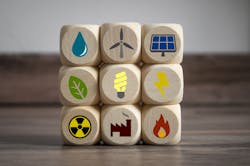Biden signs the IRA: $350B plus in Microgrid, EV & Clean Energy Incentives
Whether the landmark $750 billion Inflation Reduction Act really has anything to do with cutting inflation is a hazardous guess at best, but proponents wholeheartedly believe it will reap huge dividends in the battle against climate risk.
President Biden signed the IRA into law today, ending months of wrangling around the ill-fated and more ambitious Build Back Better legislation. This time around, Biden’s fellow Democrat, West Virginia Sen. Joe Manchin, quit playing the president’s foil and helped usher in a massive package of tax credits and incentives for clean energy technologies.
"President Biden and Congressional Democrats have worked together to deliver a historic legislative achievement that defeats special interests, delivers for American families, and grows the economy from the bottom up and middle out," the White House said in a recent statement.
Sidebar Q&A on Impacts of the IRA: Reid Morrison, global energy leader at PwC
The president, mired in low approval ratings and seemingly feckless in rallying even his own troops in the past year, now can undertake a nationwide tour celebrating and explaining the new legislation which will have an impact on the energy industry for years to come.
And it clearly will take years. Much work is needed to be done on macro grid to capitalize on the opportunities afforded by the IRA clean energy funding, many say.
“To ensure the IRA is fully realized, however, we must get to work on the backbone of the energy transition: the electric grid,” Hudson Gilmer, CEO of LineVision and a co-founder of the grid-enhancing technology advocacy group WATT Coalition, pointed out. Gilmer will be one of the featured speakers at the T&D World Conference and Exhibition happening Oct. 5-7 in Charlotte.
“By many accounts, we need to double the size of the existing power grid if we are to accommodate the renewable energy assets required to meet our nation’s climate goals. And we need to accomplish this before 2030,” Gilmer said. “We are pleased that once again Congress has specifically identified Grid-Enhancing Technologies (GETs) as an important solution for clean energy integration. Building new transmission and maximizing the efficiency of the existing grid by implementing GETs must be our next priority.”
The IRA bill reinstates and expands numerous clean energy incentives with an estimated $370 billion of new energy tax credits over the next 10 years. Microgrid development also could gain a tremendous market boost as the legislation includes up to 50 percent in investment tax credits and higher production tax credits for on-site clean power development.
“Combining all the impacts, this will cut the cost of microgrids by 10 to 50 percent,” Yashar Barut, CEO of Power Market Solutions, told Microgrid Knowledge in a recent interview.
The goal of the IRA bill is to help the U.S. trim greenhouse gas emissions by 40 percent below 2005 levels to start the next decade. The current pathway predicts a 25-percent GHG cut by 2030, according to reports.
On the energy efficiency front, the bill offers tax credits and other incentives for improving the affordability of heat pumps and electrification in the residential and commercial building sector.
Senate Democrats say the funding helps consumers through a $9 billion home energy rebate program for buying electric home appliances and retrofits. Much of these allocations focus on low-income consumers, according to reports.
The next decade could accelerate public sector assistance in rooftop solar, electric heating and cooling and electric water heaters. Individuals who buy used electric vehicles could receive $4,000 in tax credits, and $7,500 if they acquire a new EV.
Biden’s last major legislative accomplishment, last year’s $1 trillion Bipartisan Infrastructure Law, allocated $65 billion toward electric grid transmission infrastructure upgrades and construction. It also promised a $7.5 billion investment to build out a national network of EV chargers.
-- -- --
(Rod Walton, senior editor for EnergyTech, is a 14-year veteran of covering the energy industry both as a newspaper and trade journalist. He can be reached at [email protected]).
About the Author
Rod Walton, EnergyTech Managing Editor
Managing Editor
For EnergyTech editorial inquiries, please contact Managing Editor Rod Walton at [email protected].
Rod Walton has spent 17 years covering the energy industry as a newspaper and trade journalist. He formerly was energy writer and business editor at the Tulsa World. Later, he spent six years covering the electricity power sector for Pennwell and Clarion Events. He joined Endeavor and EnergyTech in November 2021.
Walton earned his Bachelors degree in journalism from the University of Oklahoma. His career stops include the Moore American, Bartlesville Examiner-Enterprise, Wagoner Tribune and Tulsa World.
EnergyTech is focused on the mission critical and large-scale energy users and their sustainability and resiliency goals. These include the commercial and industrial sectors, as well as the military, universities, data centers and microgrids. The C&I sectors together account for close to 30 percent of greenhouse gas emissions in the U.S.
He was named Managing Editor for Microgrid Knowledge and EnergyTech starting July 1, 2023
Many large-scale energy users such as Fortune 500 companies, and mission-critical users such as military bases, universities, healthcare facilities, public safety and data centers, shifting their energy priorities to reach net-zero carbon goals within the coming decades. These include plans for renewable energy power purchase agreements, but also on-site resiliency projects such as microgrids, combined heat and power, rooftop solar, energy storage, digitalization and building efficiency upgrades.

